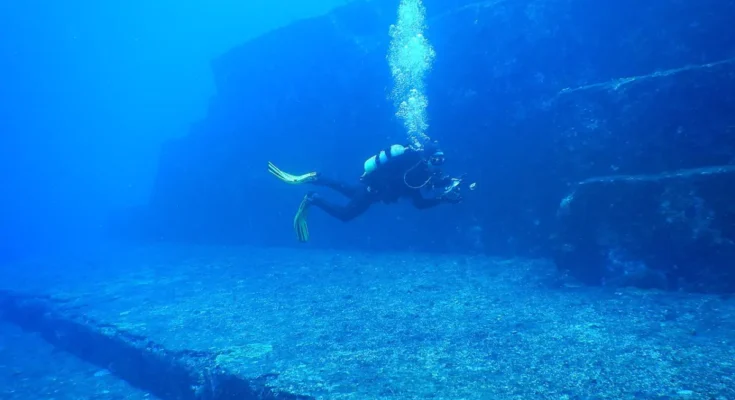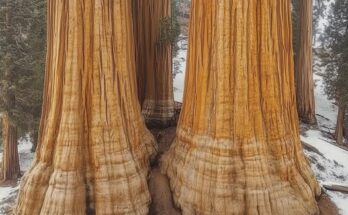Is Japan’s remarkable underwater structure, the Yonaguni Monument, a product of natural geological forces or a remnant of a fabled lost civilization?
Deep beneath the turquoise waters off the coast of Yonaguni Island, Japan, lies a colossal enigma: the Yonaguni Monument, also known as “Yonaguni (Island) Submarine Ruins.” Rising 45 meters from the seabed, this imposing structure boasts geometric terraces, seemingly carved steps, and even mysterious hieroglyph-like markings.

Is the Yonaguni Monument a marvel of ancient human engineering, a lost underwater city, or simply a whimsical creation of Mother Nature? This question has captivated divers, archaeologists, and conspiracy theorists alike for decades.
The story begins in 1985 with Kihachiro Aratake, a local diving instructor exploring the Yonaguni coral reefs. As he maneuvered around the rocky landscape in search of a good spot to observe hammerhead sharks, he stumbled upon a sight that made his heart skip a beat: a massive, rectangular platform etched with straight lines and sharp angles.
The news of this underwater anomaly quickly spread, and has since attracted the attention of many researchers, divers and tourists who debate whether it is a natural formation or a remnant of an ancient civilization.

The monument consists of a series of massive sandstone blocks that form a stepped pyramid-like shape. It measures about 50 meters long and 20 meters wide, and lies at a depth of about 26 meters. Some of the blocks have straight edges, right angles and flat surfaces, while others have curved shapes and grooves that resemble carvings.
The monument also has features that resemble pillars, arches, terraces, staircases and even roads. Nearby, there are other smaller structures that seem to be part of a larger complex.

The origin and age of the Yonaguni Monument are much debated. Some scholars, most notably marine geologist Masaaki Kimura from the University of the Ryukyus, claim that it is a man-made structure that dates back to at least 5,000 years ago. They argue that it was built by a lost civilization, possibly the mythical Mu or Lemuria, or even Atlantis, that was submerged by a cataclysmic event such as an earthquake or a tsunami.
The proponents of the “human-made” theory point to the geometric features, the presence of “steps” and “ramps,” the carvings and the alignment of the monument with the cardinal directions and the solstices as evidence of intelligent design.

Other scholars, however, maintain that it is a natural formation that was shaped by erosion and tectonic movements over millions of years. They point to the region’s unique geology, where tectonic plates collide and powerful underwater currents carve bizarre formations into the sandstone bedrock. The regular geometric shapes, they claim, are simply a result of natural fractures and erosion patterns along natural joints and faults.
The proponents of the “natural” theory explain that the straight lines and angles are common in sedimentary rocks due to their layered structure and cleavage planes. They also suggest that the carvings are actually scratches made by underwater eddies or marine organisms, or tools used by divers.

The debate over the Yonaguni Monument is not likely to be resolved soon, as there is no definitive proof for either hypothesis. The Japanese government does not recognize it as a cultural artifact and has not conducted any official research or preservation work on it. The only way to explore it is by diving, which requires a permit and a guide. The site is also subject to strong currents and poor visibility, making it challenging and potentially dangerous to visit.

The Yonaguni Monument remains one of the most intriguing and controversial underwater mysteries in the world. It invites us to question our assumptions about history, culture and nature, and to wonder what secrets lie beneath the waves.



